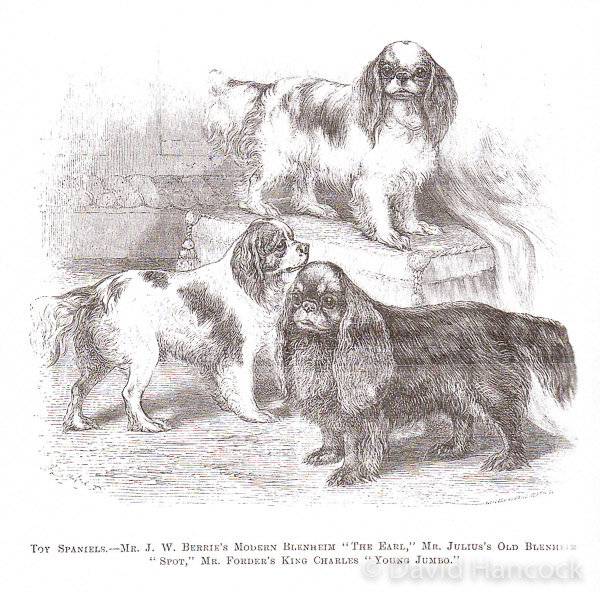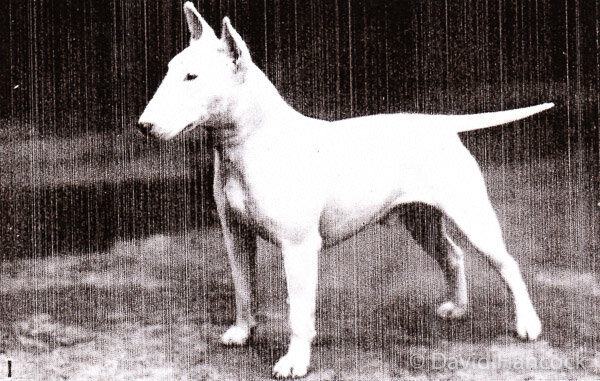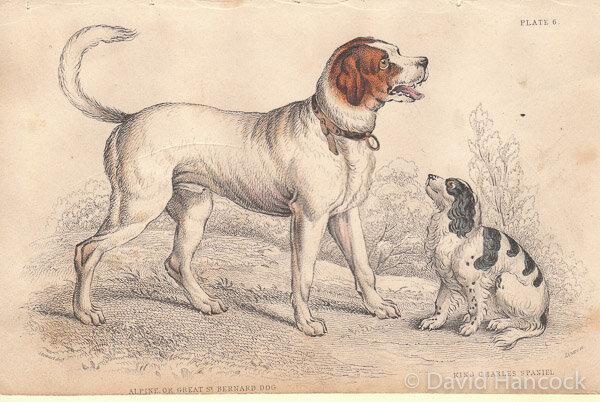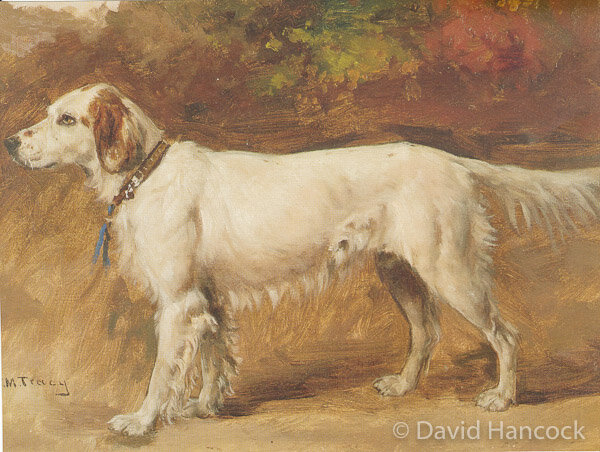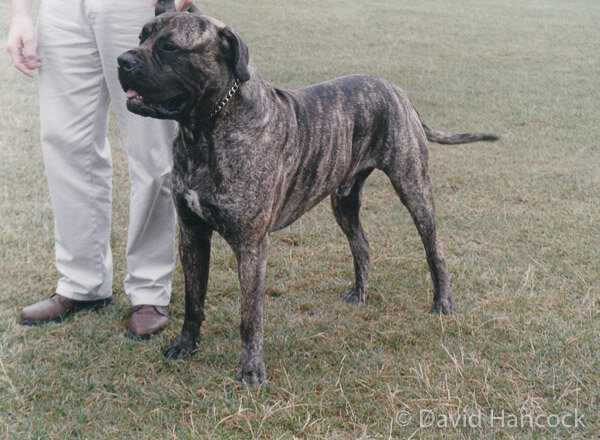1168
DISRESPECTING ORIGINS
By David Hancock
A century or so ago, an American dog-lover, Roswell Eldridge, was so perturbed when visiting England to see what English fanciers had done to the King Charles Spaniel that he decided to do something about it. He offered prizes every year for five years at Crufts Dog Show for: "The best dog and the best bitch exhibited in a class for Blenheim Spaniels of the old type, as shown in the pictures of Charles II's time: long face, no stop, flat skull, not inclined to be 'domed' -- with spot on centre of skull." He had been appalled by the flat-nosed, almost muzzle-less monstrosities, usually also featuring protruding runny eyes and misshapen skulls, masquerading as King Charles Spaniels in the British show rings. Some of the more enlightened breeders responded and in due course the longer nosed Cavalier King Charles Spaniel was registered and the public have since demonstrated their views: in 2003 there were 10,600 registrations of Cavaliers and only 176 of the squashed faced kind, the King Charles; a very public response. Apart from the shame of it having to take an overseas visitor to show us the error of our ways, this is a most encouraging story for those who believe that there are around twenty registered breeds of pedigree dog which would undoubtedly gain from such a visionary benefactor today. The general public are given the very definite impression at shows such as Crufts that purebred dogs are being firstly perpetuated in the mould of their ancestors and secondly bred healthily and soundly. If only it were true. Far too many of our native breeds and those we have elected to import are being bred to a design quite unlike that desired in the early specimens.
British dog breeders are sometimes accused of placing 'type', i.e. those physical attributes which make a breed of dog identifiable from other breeds, ahead of soundness. I believe however that many are guilty of something much more reprehensible: the harmful exaggeration of type. This has been variously attributed to: the personal whim of one wealthy influential breeder, a dominant clique in a breed club, an uncharacteristic trait appearing in a breed which is easier to claim falsely as typical than to breed out and a misplaced desire to 'improve' a breed according to contemporary criteria. In such a way, has the Bull Terrier been given piggy eyes and a rugger-ball for a head, the German Shepherd Dog made to look like a heftier coyote, the Mastiff made into a fawn Alpine Mastiff, the Scottish Terrier given the appearance of an animated hovercraft and the Bulldog an anatomy that defies nature in every limb. The explanations given by breeders for such irrational and often irresponsible behaviour range from the bizarre to the foolish but are never convincing. Why should we need to inflict handicaps on breeds skilfully developed by master breeders in more informed times, breeds admired all over the world for what they were? The thoroughbred horse has, after all, remained the same in appearance down the centuries.
Why does an Irish Wolfhound need legs like tree trunks when the Russian Wolfhound has legs more like a Deerhound for the same function? In big breeds, it starts I suspect, with the absurd quest for 'great bone', something our ancestors learned not to prize. This quest has led to the St Bernard now being quite unsuitable as a mountain rescue dog, the Mastiff becoming prized mainly for its size and even the Clumber Spaniel, initially developed as a 40lb hunting dog, now actually being required to be twice that weight in its Breed Standard. The admirable enthusiasts now striving to revive the working instincts of this distinguished sporting breed use dogs weighing nearer 40lbs. Why breed a dog away from its desired function? Perhaps the show dogs should be renamed Lumber Spaniels and abandon function altogether!
At the turn of the century, the Foxhound fraternity lost its way, producing heavy-boned, fleshy-footed, massive-fronted, balloon-chested hounds which were out at elbow, knuckled-over at the knee and had turned-in toes. It took the character, vision, stubbornness and persistence of dedicated men like the renowned 'Ikey' Bell to change attitudes, return to time-honoured and proven structure and away from 'fad of the day'. What convinced the misguided and eventually won the day was the superior performance in the hunting field of the lighter boned, less cumbersome, better constructed hounds. Functional merit should always prevail over fashion and human whim. The Foxhound was fortunate in having a function to decide the day. Most contemporary pedigree breeds do not. The fashion however for the Belvoir tan (a rich mahogany tan offset by only a little white) in the Foxhound led to many high-quality, mainly-white hounds, which excelled in the field, never being bred from. Once again, performance being threatened by fashion.
Breeds with profuse coats are much loved on the show circuit. The Shetland Sheepdog, originally just a smaller working sheepdog, now resembles a large Pomeranian with a lowered tail. The American Cocker Spaniel, still classified by the Kennel Club as a gundog, is rapidly becoming a legless Standard Poodle, all coat and no identity. The Afghan Hound, once a noble sighthound, is now taken to shows wearing a shell-suit and bootees, because the dog's coat is considered more important than the dog's dignity. The coursing hounds are proud dogs; I hate seeing them humiliated in this way. Dogs of course are subject creatures, vulnerable to man's whim and his temper. I feel sad when I see the anatomy we have knowingly, and with selfish human intent, inflicted on the Basset Hound, the Dachshund, the Yorkshire Terrier, the Mastiff, the Bloodhound and the Bulldog. I despair when I see Clumber Spaniels at Crufts with red-raw eyes, a distressing common feature of the show specimens that could so easily be bred out. It is depressing to hear of champion Bulldogs dying at four years of age when vigour could so quickly be bred-in. I hate seeing a quite admirable breed like the German Shepherd Dog turned into a coyote-backed, gaiting dog, without any purpose or justification and with so little gratitude for their simply outstanding service to man.
I smile ruefully when I see English Setters in "Pride and Prejudice" on TV inaccurately displaying the needlessly-lavish leggings of the modern show-ring type. I strongly disapprove of the heavy profusion of coat in contemporary examples of old working breeds like the Rough Collie, the Old English Sheepdog and the Bearded Collie. They have become like mink, valued only for their coats. Pioneer breeders like HA Titley in Bobtails and James Garrow in Beardies always stressed the perils of allowing the coat of a working breed to become a liability. What really is the point of favouring a breed if you then spend your life turning it into something different? Why handicap a Dachshund with too short a leg and a keel scraping the ground? The old working ‘badger-dogs’ were far higher on the leg.
The original standard of the Bullmastiff set the minimum weight of the male at 90lbs, a standard established by men who employed the Bullmastiff as a working breed. The renowned dogs at the time when detaining poachers was their role in life were Thorneywood Terror, reputed to be the best trained night-dog of its day and Osmaston Daisy and Viper, celebrated catchers of poachers. None of them was over 90lbs. The breed standard now stipulates a minimum weight for a dog as 110lbs and the quest is always on for 'great bone' in the breed. It doesn't seem to matter whether the Bullmastiff needs such size; substance in the show ring is the only criterion. What is the value of great size without activity, agility and athleticism in a working breed?
Regrettably, the ultimate authority in the world of purebred dogs, the Kennel Club, takes the view that the future of each breed lies with the breed clubs concerned. This is commendably democratic in theory but disgracefully irresponsible in practice. The KC, with some justification, expects breed clubs to have the best interests of their breed forever in mind. This is at best naive and at worst an abrogation of responsibility. Of course, there are some admirable breed clubs, but such clubs so often mirror society, in that position and power are more likely pursuits than selflessness and honour. Feuding between and within breed clubs is a sad feature of the pedigree dog world. People who care more about their personal position than the well-being of their breed are unlikely agents for the protection of traditional form and the pursuit of healthier dogs. Origin matters! What truly is the benefit to, say, the Bloodhound of an over-wrinkled head, loose lips and loose eyes?
It is against this background of breeding folly that breeds get lost and their club officials proceed without a parent body to question their motives and see through their less creditable activities. In this way, breed features which harm a breed and limit a dog's ability to lead a healthy life become acceptable as permanent, even desirable. At a time when veterinary and genetic advice, supported by authoritative action by the only body able to do so - the Kennel Club, is urgently needed, what do we actually have? Breed clubs being allowed to ignore advice from geneticists which would produce healthier dogs. No attempt made to record on computerised registers the faults and flaws of sires and dams to reduce the likelihood of disabled puppies. No steps being taken to breed out harmful breed features such as oversized heads. In short, moral anarchy. Breeds deserve not public apathy or breeder folly but sound custodianship. We could do so much more to protect our living heritage- our dogs trust us! We should have both the respect for, and see the value of, every breed’s origins.


